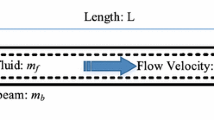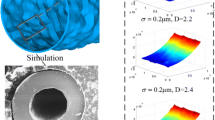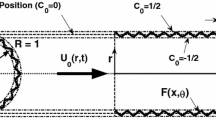Abstract
In this article, the instability and dynamic characteristics of fluid-conveying microtubes with surface roughness are studied. A theoretical model is presented to describe the dynamic behaviors of rough microtubes by introducing correction factors, which account for the effects of the surface roughness both on the structure and the internal fluid. The results demonstrate that the surface roughness has little effect on the correction factors for structure, but dramatically decreases the correction factors for fluid, which indicates that the Coriolis force and centripetal force caused by the internal fluid are reduced. For clamped–clamped microtubes, the surface roughness makes the nondimensional critical velocity for divergence and the natural frequency increase. And as the roughness height or the wave number increases, both the critical velocity and the frequency increase. For cantilevered microtubes, the critical velocity for fluttering depends on the surface roughness and the mass ratio. Curves describing the relationship between the nondimensional critical velocity \(\hat{U}_{\text{cr}}\) and the mass ratio \(\beta\) for smooth and rough microtubes are presented. Each curve contains a S-shaped segment, which is associated with the instability–restabilization–instability sequence. The surface roughness induces the curve shifting to the upper right of the \(\hat{U}_{\text{cr}}\) − \(\beta\) plane. In the region far away from the S-shaped segment, the critical velocity increases with the increasing of roughness height. And in the vicinity of S-shaped segment, the critical velocity for the rough microtube may be less than the value for the smooth microtube because of the sharply varying of critical velocity with mass ratio. The effects of surface roughness on the frequency of cantilevered microtubes are also analyzed and discussed.
















Similar content being viewed by others
References
Akyildiz FT, Siginer DA (2017) Exact solution for forced convection gaseous slip flow in corrugated microtubes. Int J Heat Mass Transf 112:553–558
Bobovnik G, Kutin J (2018) Numerical study of the fluid-dynamic loading on pipes conveying fluid with a laminar velocity profile. J Fluids Struct 80:441–450
Dai J, Liu Y, Tong G (2020) Stability analysis of a periodic fluid-conveying heterogeneous nanotube system. Acta Mech Solida Sin 33:756–769
Dehrouyeh-Semnani AM, Nikkhah-Bahrami M, Yazdi MRH (2017) On nonlinear stability of fluid-conveying imperfect micropipes. Int J Eng Sci 120:254–271
Dey P, Saha SK (2021) Fluid flow and heat transfer in microchannel with porous bio-inspired roughness. Int J Therm Sci 161:106729
Duan Z, Muzychka YS (2008) Effects of corrugated roughness on developed laminar flow in microtubes. J Fluids Eng Trans ASME 130:031102
Ghayesh MH, Farajpour A, Farokhi H (2019) Viscoelastically coupled mechanics of fluid-conveying microtubes. Int J Eng Sci 145:103139
Ghazavi MR, Molki H, Beigloo AA (2018) Nonlinear analysis of the micro/nanotube conveying fluid based on second strain gradient theory. Appl Math Model 60:77–93
Giacobbi DB, Semler C, Païdoussis MP (2020) Dynamics of pipes conveying fluid of axially varying density. J Sound Vib 473:115202
Guo CQ, Zhang CH, Paidoussis MP (2010) Modification of equation of motion of fluid-conveying pipe for laminar and turbulent flow profiles. J Fluids Struct 26:793–803
Hosseini M, Bahaadini R (2016) Size dependent stability analysis of cantilever micro-pipes conveying fluid based on modified strain gradient theory. Int J Eng Sci 101:1–13
Hu K, Wang YK, Dai HL, Wang L, Qian Q (2016) Nonlinear and chaotic vibrations of cantilevered micropipes conveying fluid based on modified couple stress theory. Int J Eng Sci 105:93–107
Jaeger R, Ren J, Xie Y, Sundararajan S, Olsen MG, Ganapathysubramanian B (2012) Nanoscale surface roughness affects low Reynolds number flow: experiments and modeling. Appl Phys Lett 101:184102
Kim J, Song J, Kim K, Kim S, Song J, Kim N, Khan MF, Zhang L, Sader JE, Park K, Kim D, Thundat T, Lee J (2016) Hollow microtube resonators via silicon self-assembly toward subattogram mass sensing applications. Nano Lett 16:1537–1545
Li L, Hu YJ, Li XB, Ling L (2016) Size-dependent effects on critical flow velocity of fluid-conveying microtubes via nonlocal strain gradient theory. Microfluid Nanofluidics 20:76
Li Q, Liu W, Lu K, Yue Z (2020) Nonlinear parametric vibration of a fluid-conveying pipe flexibly restrained at the ends. Acta Mech Solida Sin 33:327–346
Lyu X, Chen F, Ren Q, Tang Y, Yang T (2020) Ultra-thin piezoelectric lattice for vibration suppression in pipe conveying fluid. Acta Mech Solida Sin 33:770–780
Mainak M, Nitin C, Rodney A, Hinds BJ (2005) Nanoscale hydrodynamics: enhanced flow in carbon nanotubes. Nature 438:44
Mala GM, Li DQ (1999) Flow characteristics of water in microtubes. Int J Heat Fluid Flow 20:142–148
Marusic-Paloka E, Pazanin I (2020) Effects of boundary roughness and inertia on the fluid flow through a corrugated pipe and the formula for the Darcy–Weisbach friction coefficient. Int J Eng Sci 152:103293
Paidoussis MP (1998) Fluid–structure interactions: slender structures and axial flow. Academic Press, New York
Parfenyev V, Belan S, Lebedev V (2019) Universality in statistics of Stokes flow over a no-slip wall with random roughness. J Fluid Mech 862:1084–1104
Peng G, Xiong Y, Gao Y, Liu L, Wang M, Zheng Z (2018) Non-linear dynamics of a simply supported fluid-conveying pipe subjected to motion-limiting constraints: two-dimensional analysis. J Sound Vib 435:192–204
Peng G, Xiong Y, Liu L, Gao Y, Wang M, Zhang Z (2019) 3-D non-linear dynamics of inclined pipe conveying fluid, supported at both ends. J Sound Vib 449:405–426
Rahmati M, Khodaei S (2018) Nonlocal vibration and instability analysis of carbon nanotubes conveying fluid considering the influences of nanoflow and non-uniform velocity profile. Microfluid Nanofluidics 22:117
Rinaldi S, Prabhakar S, Vengallatore S, Paidoussis MP (2010) Dynamics of microscale pipes containing internal fluid flow: damping, frequency shift, and stability. J Sound Vib 329:1081–1088
Schwengber A, Prado HJ, Zilli DA, Bonelli PR, Cukierman AL (2015) Carbon nanotubes buckypapers for potential transdermal drug delivery. Mater Sci Eng C Mater Biol Appl 57:7–13
Shaat M, Faroughi S (2018) Influence of surface integrity on vibration characteristics of microbeams. Eur J Mech A Solids 71:365–377
Shaat M, Emam S, Faroughi S, Javed U (2020) On postbuckling mode distortion and inversion of nanostructures due to surface roughness. Int J Solids Struct 195:28–42
Song S, Yang X, Xin F, Lu TJ (2018) Modeling of surface roughness effects on Stokes flow in circular pipes. Phys Fluids 30:023604
Tang GH, Li Z, He YL, Tao WQ (2007) Experimental study of compressibility, roughness and rarefaction influences on microchannel flow. Int J Heat Mass Transf 50:2282–2295
Wang L (2010) Size-dependent vibration characteristics of fluid-conveying microtubes. J Fluids Struct 26:675–684
Wang L, Liu HT, Ni Q, Wu Y (2013) Flexural vibrations of microscale pipes conveying fluid by considering the size effects of micro-flow and micro-structure. Int J Eng Sci 71:92–101
Yan H, Zhang W-M, Jiang H-M, Hu K-M (2017) Pull-in effect of suspended microchannel resonator sensor subjected to electrostatic actuation. Sensors 17:114
Zhou Z, Chen D, Wang X, Jiang J (2017) Milling positive master for polydimethylsiloxane microfluidic devices: the microfabrication and roughness issues. Micromachines 8:287
Acknowledgements
The authors gratefully acknowledge the support from and the National Natural Science Foundation of China (Grant nos. 11902192 and 52005335) and the National Science Fund for Distinguished Young Scholars (Grant no. 11625208)
Author information
Authors and Affiliations
Corresponding author
Additional information
Publisher's Note
Springer Nature remains neutral with regard to jurisdictional claims in published maps and institutional affiliations.
Rights and permissions
About this article
Cite this article
Jiang, HM., Yan, H. & Zhang, WM. Effects of surface roughness on the stability and dynamics of microtubes conveying internal fluid. Microfluid Nanofluid 25, 67 (2021). https://doi.org/10.1007/s10404-021-02468-1
Received:
Accepted:
Published:
DOI: https://doi.org/10.1007/s10404-021-02468-1




